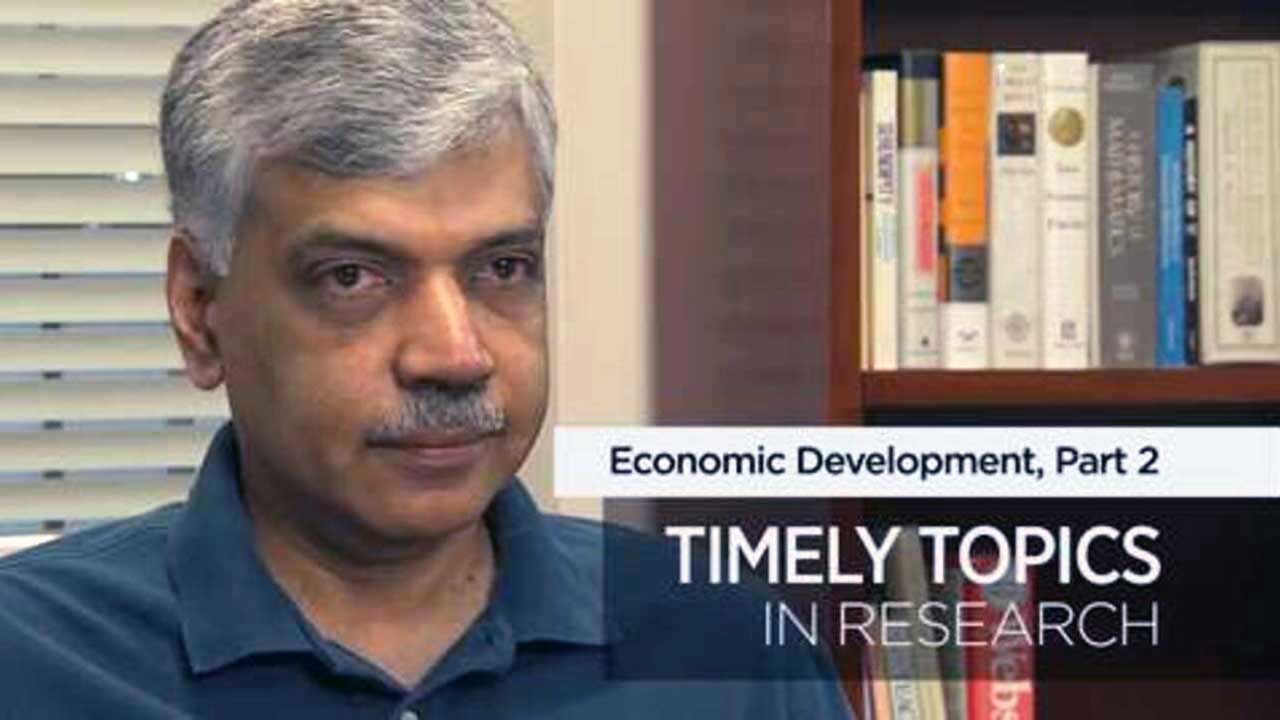Video: Reducing Trade Barriers to Close the Gap between Rich and Poor Countries

[MUSIC PLAYING]
So in this paper, my co-authors and I are trying to look at what's the effect of capital goods trade on cross-country income differences. The gap between poor countries and rich countries in our sample it's a factor of more than 20. Imagine a person living at $1 a day and compare that to a person living at $20 or $25 a day. Capital goods trade, if you remove the barriers, would improve the situation. That gap closes by a half. So the gain in standard of living is very important when you think about various factors that could contribute to improvements of standards of living.
[MUSIC PLAYING]
My name is Ravikumar. I am an economist at the Federal Reserve Bank of St. Louis. I've been here since summer of 2011. Now, there are two ways in which this gap is closing. One because of capital goods trade, the physical capital in a poor country is much higher than what it would have been in the presence of trade barriers.
Physical capital could be all kinds of equipment and structure sitting in an economy. And second factor is that the total factor productivity in a poor country is higher than what it would have been in the presence of trade barriers. So this is an example of a trade barrier is what's preventing poor countries from importing more cars from Germany, more tractors from the U.S. or more computers from anywhere else.
Trade Barriers: Tariff Rates and Quotas
These barriers come in various forms. So one of them is tariff rates. Imports are taxed at a different rate compared to say, a sales tax in a domestic economy. So there's an extra tax to be paid if the particular object comes from abroad. The other barrier is in the form of non-tariff quotas, so poor countries could have a barrier. You can import only so many cars per year. So that form comes in the form of quotas.
So lots of countries have this not just poor countries, but it might be useful to step back a little bit. So if you think about physical capital sitting in a country, it's a result of years and years of investment that's been made in that country. In the case of a poor country, this years and years of investment is in the form of capital goods imports coming from other countries.
Total Factor Productivity
So trade and capital goods is important for the stock of physical capital sitting in the poor country because they rely on capital goods imports. The efficiency with which these resources are used are typically called total factor productivity. So a country that uses the resources efficiently will have high total factor productivity. The country that uses the resources inefficiently will have lower total factor productivity.
So imagine a case of Argentina versus Germany. In a world without any barriers, Argentina would be exporting beef to Germany, and Germany would be exporting cars to Argentina. So relatively speaking, Germany is efficient at producing cars, and relatively speaking, Argentina is efficient at producing beef. When you have barriers, some resources in Argentina are being allocated to the production of cars, and some resources in Germany are being allocated to the production of beef. The resources are being used inefficiently, so that means total factor productivity in both countries are affected.
Income Gap
And in a world with barriers, not enough cars are flowing from Germany to Argentina. So the physical capital in Argentina is going to look very different compared to a world without barriers. When you remove all the barriers to trade, the capital goods flows more freely across countries, and this is benefiting both parties.
So our finding is that in the cross section of countries in our sample, the income gap between rich countries and poor countries closes by a factor of 50%. 80% of the gains is as a result of higher physical capital, and 20% of the gains is because of higher total factor productivity.
So all of a sudden, this gap of $1 versus $20 is now -- the gap is more like $10 versus $20. So the gain in standard of living going from $1 to $10 is enormous. So if you can improve the standard of living for the person living at $1 a day, that's enormous gain for humanity.
If barriers to trade are removed, capital goods flow more freely across countries; this benefits all parties because they all can use their resources more efficiently. The removal of trade barriers could close the income gap between rich and poor countries by 50 percent, according to research conducted by economist B. Ravikumar and his colleagues.
To learn more: Download the working paper (PDF).

